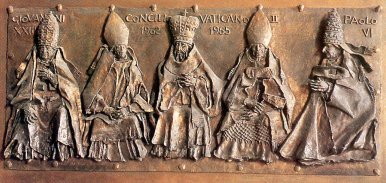- Read this.
- Realize that Dei Verbum is so awesome and short that you should probably just read it now.
- Read the rest of the council documents.
Purpose of the document: following Traidition, to teach on revelation and how revelation is handed on in order to promote its spread and increase the theological virtues of the whole world.
Chapter 1 defines revelation. It is the act of the supreme and hidden Trinity to share with us Himself. This act is realized in human fashion: in history. God prepared us for the fullness of revelation from Eden through the entire Old Testament, and perfected revelation in Christ, who made clear by His every word and action that "God is with us to free us from...sin and death, and to raise us up to life eternal." There is no new public revelation forthcoming. Revelation includes truths that trancend human deduction as well as truths that reason can attain alone but with difficulty. Our response to this revelation is total, free submission, an act of faith which requires God's grace. Turning thus to God is a lifelong conversion, deepened constantly by the Holy Spirit.
Chapter 2 explains how revelation is passed on. From Christ's first charge of "preach to all men" to the Apostles, revelation has remained in its full integrity in sacred Tradition and sacred Scripture. both of these are from the same act of God and tend toward the same end. Tradition comes from the observances handed down to the Apostles from Christ and the Holy Spirit, passed thorugh their successors; Scripture is the message of Salvation committed to writing under the same Spirit. Scripture supports Tradition (see 2 Thess 2:25, Jude 1:3) and vis a versa. The two form a single "sacred deposit" which the Church treasures, contemplates, and serves: treasures by keeping its precpts and spreading its message; contemplates by continually growing in understanding its contents; and serves by exercise of the teaching office, which exclusively authentically interprents the Word of God. This last guards revelation scrupulously, listens to it devoutly, and explains it, faithful to the inspiritations of the Holy Spirit.
Chapter 3 epxlains the itnerpretation of Scripture. The Old and New Testaments have God as their author and teach without error His revelation. God composed sacred Scripture by choosing men who made use of their powers and, as true authors, wrote in human fashion with literary forms of their time, writing only what God intended. To rightly receive Scripture, its Truth must be searched out. This Truth coheres internally and with Tradition, but is variously expressed in texts of different times and styles. All exegesis is subject to the Church, which guards the word of God, "for the words of God, expressed in human language, have been made like human discourse, just as the word of the eternal Father...was in every way made like men."
Chapter 4 states the puprose of the Old Testament. It tells of God's works "to prepare for the coming of Christ, the redeemer of all and of the messianic kingdom, to announce this coming by prophecy and to indicate its meaning by various types." The New is hidden in the Old and the Old is made manifest in the New.
Chapter 5 states that the New Testament "stand[s] as a perpetual and divine witness" to the Word of God, who was made flesh to manifest God and draw all men to Himself. The fourfold gospel, a selection of the acts of Jesus, is of apostolic origin and faithfully hands on what He did and taught for our salvation. The other contents of the New Testament confirm and more fully state the true teaching of Christ (an example of the Church's mission outlined in Chapter 2), begin the history of the Church, and foretell her fulfillment.
Chapter 6 describes the place of Scripture in the Church. It is to be venerated, and maintained with Tradition the supreme rule of faith. It nourishes and regulates the Church (Acts 20:32, see 1 Thess 2:13), and since it is an encounter with her Bridegroom, she is eager to delve deeper into it. She recommends it as the foundation of all theology and preaching, and encourages all (especially theologians, clergy, and consecrated persons) to study it following "the mind of the Church." It should be made available to all (including non-believers and separated brethren) in various languages in order to spread the Word of God. Finally, all study should be accompanied with prayer, "so that God and man may talk together" and "we may hope for a new stimulus for the life of the Spirit from a growing reverence for the Word of God, which 'lasts forever.' (Is 40:8, see 1 Pt 1:23-25)"

No comments:
Post a Comment